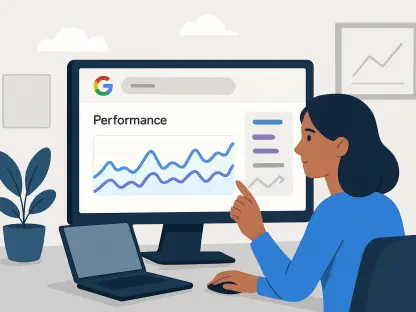In today’s fast-paced digital landscape, marketing professionals face an unprecedented challenge: navigating a sea of data from clicks, purchases, browsing habits, and social interactions while meeting consumer expectations for personalized, immediate, and relevant engagement. This balancing act has pushed the demand for cutting-edge tools that can transform raw information into actionable insights to an all-time high. Enter predictive marketing—a game-changing approach that leverages artificial intelligence (AI) and machine learning (ML) to analyze historical customer data and forecast future behaviors. This technology empowers brands to adopt proactive strategies rather than reactive ones, ensuring they stay ahead of the curve. Companies embracing predictive analytics have reported sharper targeting, reduced client acquisition costs, and stronger customer loyalty, marking a significant shift in how businesses approach growth. This article delves into the mechanics, benefits, and real-world applications of this transformative tool, offering a clear roadmap for implementation and highlighting its strategic importance in modern marketing.
1. Defining Predictive Marketing and Its Critical Role
Predictive marketing hinges on the power of predictive analytics, a sophisticated blend of statistical algorithms and machine learning models that analyze past data to anticipate future outcomes. This approach moves beyond mere intuition, providing concrete forecasts for key business areas such as lead scoring to identify high-conversion prospects, churn prediction to spot at-risk customers before they leave, product recommendations based on prior behaviors, and customer lifetime value (CLV) modeling to estimate long-term client worth. Far from being speculative, this method is grounded in data-driven precision. Research from McKinsey indicates that organizations adopting predictive analytics can boost marketing ROI by 15–20%, demonstrating its tangible impact on efficiency and profitability. This technology enables marketers to allocate resources more effectively, focusing on high-potential opportunities rather than casting a wide, inefficient net across all prospects.
Beyond its technical capabilities, predictive marketing represents a cultural shift within organizations. Teams must adapt by placing trust in AI-driven models, experimenting with data-informed triggers, and embedding these insights into daily operations. This transition is not always seamless, as it requires a mindset change from traditional marketing tactics to a science-based approach. When executed well, however, the results are transformative, turning client acquisition from a scattered effort into a precise, measurable discipline. The importance of this shift cannot be overstated, as staying competitive in today’s market increasingly depends on the ability to anticipate customer needs before they even arise, ensuring sustained engagement and loyalty.
2. The Compelling Business Case for Predictive Marketing
The financial argument for adopting predictive marketing is striking, with marketers utilizing predictive analytics being nearly three times more likely to surpass competitors in revenue growth. This statistic underscores a fundamental truth: predictive marketing doesn’t merely enhance operational efficiency—it redefines the economics of client acquisition. By pinpointing prospects with the highest potential return, businesses can channel budgets into targeted campaigns rather than dispersing funds across broad, less effective channels. This focused allocation of resources maximizes impact, ensuring that every dollar spent contributes directly to growth. The ability to predict which leads are most likely to convert or which customers might churn allows for strategic interventions that drive measurable outcomes.
Moreover, the ripple effects of predictive marketing extend beyond immediate financial gains. By reducing wasteful spending on low-yield efforts, companies can reinvest savings into innovation, product development, or enhanced customer experiences. This creates a virtuous cycle where improved targeting leads to better results, which in turn fuels further optimization. The data also supports long-term benefits, as personalized interactions driven by predictive insights foster deeper customer relationships, ultimately boosting retention rates. In an era where competition for consumer attention is fierce, the ability to operate with such precision provides a distinct edge, positioning adopters as leaders in their respective markets.
3. Real-World Success Stories with Predictive Marketing
One standout example of predictive marketing in action is American Express, which tackled the costly issue of customer churn in the financial services sector. By deploying predictive analytics to monitor transaction patterns, credit usage, and engagement levels, the company identified customers at risk of leaving before they made the decision to disengage. Targeted retention strategies were then applied, such as personalized offers or proactive communication, which significantly reduced the need to spend on acquiring new clients to replace lost ones. This approach not only saved substantial costs but also reinforced customer trust by demonstrating a proactive commitment to meeting individual needs, proving the value of predictive tools in high-stakes industries.
Another powerful case is Netflix, whose recommendation engine has become a benchmark for predictive marketing at scale. By analyzing billions of viewing hours, the platform predicts what users are likely to watch next, driving an impressive 75% of user activity through tailored suggestions. This personalization has translated into annual savings of $1 billion by preventing churn, as engaged users are far less likely to cancel their subscriptions. Meanwhile, luxury retailer Zegna utilized AI to offer hyper-personalized outfit recommendations, generating 49 billion unique combinations for online and in-store experiences. Customers engaging with this feature spent 75% more, illustrating how predictive marketing can redefine the customer journey in premium markets and deliver outsized returns.
4. A Strategic Guide to Implementing Predictive Marketing
Step 1: Establish a Solid Database
The foundation of effective predictive marketing lies in robust data collection. Businesses must aggregate comprehensive information from web interactions, mobile usage, CRM systems, and even offline customer touchpoints. AI models thrive on unified, structured data, and their performance hinges on the quality and breadth of the input they receive. Fragmented or unstructured data can lead to inaccurate predictions, undermining the entire effort. Therefore, establishing a centralized data repository that captures a holistic view of customer behavior is critical. This step ensures that the insights generated are both reliable and actionable, setting the stage for successful predictive campaigns that can adapt to diverse customer profiles.
Step 2: Choose and Train Models
Selecting the right predictive models is essential for translating data into meaningful forecasts. Options include regression models to predict purchase likelihood, classification models to assess churn risk, and uplift modeling to evaluate the incremental impact of marketing actions. Each model must be trained on historical data specific to the business’s goals and customer base to ensure relevance. This process involves continuous refinement, as models need to adapt to evolving patterns and market conditions. By tailoring the approach to specific objectives, such as identifying high-value leads or preventing attrition, marketers can maximize the accuracy and utility of their predictions, driving better decision-making across campaigns.
Step 3: Integrate with Campaigns
Predictions alone are insufficient; they must be seamlessly integrated into actionable marketing campaigns. For instance, a high churn score might trigger targeted retention discounts, while a high lead score could fast-track a prospect to the sales team. Similarly, product affinity scores can inform cross-sell offers tailored to individual preferences. This integration requires alignment between data insights and operational workflows, ensuring that predictions directly influence customer interactions. By embedding predictive outcomes into real-time campaign adjustments, businesses can respond swiftly to emerging opportunities or risks, enhancing both customer satisfaction and conversion rates in a dynamic market environment.
Step 4: Monitor Performance Continuously
Ongoing evaluation is crucial to validate the effectiveness of predictive marketing initiatives. Key performance indicators (KPIs) such as Mean Time to Response (MTTR), conversion uplift, customer lifetime value, and reduced acquisition costs should be tracked diligently. Additionally, predictive AI campaigns must be A/B tested against control groups to confirm their ROI and identify areas for improvement. This continuous measurement ensures that strategies remain aligned with business goals and adapt to changing customer behaviors. Regular assessment also builds confidence in the predictive models, encouraging wider adoption across teams and reinforcing a data-driven culture within the organization.
Step 5: Prioritize Ethics and Privacy
The use of AI in marketing raises important ethical and privacy concerns that cannot be overlooked. Compliance with regulations like GDPR is non-negotiable, requiring transparent handling of customer data and clear communication about its usage. Marketers must adopt explainable AI frameworks to demystify how predictions are made, fostering trust among consumers. Addressing potential biases in algorithms is equally important to ensure fair treatment across diverse customer segments. By prioritizing ethical practices, businesses not only mitigate legal risks but also build stronger relationships with customers who value transparency and respect for their privacy in an increasingly data-conscious world.
5. Unlocking the Strategic Advantage of Predictive Marketing
The true strength of predictive marketing extends beyond operational efficiency to drive genuine innovation. Companies can test new product launches with segments showing the highest predicted interest, minimizing risk and optimizing rollout strategies. Similarly, expansion into new markets becomes more precise by leveraging lookalike audience analysis to identify untapped opportunities with similar characteristics to existing customers. This targeted approach reduces uncertainty and enhances success rates in unfamiliar territories. Predictive marketing also enables scalability, allowing businesses to refine their focus on high-impact areas while maintaining agility in response to market shifts.
Additionally, predictive marketing automates personalization at an unprecedented scale, freeing up human resources for higher-level strategic thinking and creative storytelling. Rather than replacing marketers, this technology acts as a powerful enabler, equipping teams with insights to make smarter, faster decisions. The result is a synergy between data-driven precision and human intuition, where campaigns are not only more effective but also more engaging. This dual advantage positions predictive marketing as a cornerstone of modern business strategy, empowering organizations to stay competitive in a landscape where customer expectations continue to evolve at a rapid pace.
6. Shaping the Future of Client Acquisition
Reflecting on the journey of predictive marketing, it has become evident that this approach has established itself as an indispensable pillar of AI-driven growth. Companies like Netflix, which saved $1 billion annually through churn prevention, and Zegna, which saw a 75% increase in luxury spending via personalized recommendations, demonstrate the scalability and impact of these strategies. These successes highlight how data-informed decisions and tailored interactions foster lasting customer loyalty across diverse industries. The adoption of predictive tools has reshaped how businesses approach acquisition, turning it into a precise science rather than a guessing game.
Looking ahead, the democratization of AI technology means even smaller enterprises can harness predictive marketing to level the playing field. The competitive landscape has shifted, making the decision to adopt these tools less a choice and more a necessity for survival. Businesses should focus on building robust data infrastructures, selecting the right models, and prioritizing ethical practices as immediate next steps. Embracing continuous learning and adaptation will ensure sustained relevance, while exploring innovative applications of predictive insights can unlock new growth avenues. The path forward lies in leveraging this technology not just to keep pace, but to redefine industry standards.









